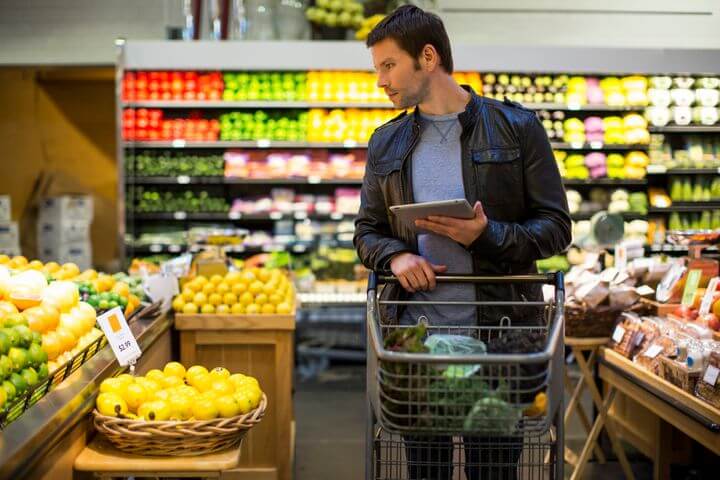Topic: The food we eat
Objectives:
- Practise understanding paraphrasing;
- Practise a Summary completion task,
- Practise basic paragraph structure for a Task 2 essay;
- Practise language for giving examples
I. Answer the questions:
1. How often do you buy these things?
- Books
- Magazines or newspapers
- Stationery (e.g. pens and paper)
- DVDs
- Greeting cards (e.g. birthday cards)
2. Where do you usually buy these things?
- In a supermarket
- In a department store
- In a smaller shop
- Online.
3. What are the advantages and disadvantages of shopping in supermarkets?

II. WRITING:
1a. Read the writing task and underline the key words. Then choose the correct answer in the question below:
People should only buy locally grown food; it is better for individuals and society.
To what extent do you agree with this statement?
What do you need to do in your essay?
- Describe a problem and present a solution
- Present and explain your opinion
- Discuss two sides of an argument
Today supermarkets sell all sorts of natural and processed foods from all over the world. However, many people think that we should only eat meals we prepare ourselves from products that are grown locally. I totally agree with this statement.
Firstly, we get many advantages from eating food that is grown in the part of the world where we live. Local foods, for instance, taste better because they are fresher. They also have all natural vitamins and other nutrients that we need. Eating local food means that we cannot have, for example, strawberries at all times of the year, but I think this is a good thing. If you can only eat them when they are available locally, that makes them more special.
Secondly, buying food that has travelled a long way is not good for society. Flying produce to Europe or the USA from a place such as Australia or South Africa contributes to environmental problems like air pollution, one of the main reasons for climate change. When the food arrives at an airport on the other side of the world, but then usually goes by lorry to supermarkets across the continent. This leads to busy roads, which is bad for the environment and also makes driving more stressful for everyone.
If we just buy food that has come from farms in our local area, our diet may be less varied, but this is not a serious problem. Both we and the planet will benefit.
2a. Look at the second paragraph in the model answer and answer the questions:
- What is the topic sentence in the paragraph?
- Do the other sentences in the paragraph explain the idea in the topic sentence or do they introduce new ideas?
- Do any of the other sentences give examples?
2b. Look at the third paragraph in the model answer. Which of the four sentences (1- 4):
- Is the topic sentence?
- Describes the next stage in a process?
- Gives a reason for the point made in the topic sentence?
- Presents what happens as a result of the situation the writer described?
2c. Number the sentences in the best order (1-4) to make a paragraph:
- It also makes it more difficult for them to get all the vitamins and nutrients that their body needs.
- In this part of the country, for example, they can eat lots of potatoes, carrots and apples but they can’t have rice, aubergines or bananas.
- People who only buy food that comes from their local area have a very limited diet.
- This means that meals are much less varied and interesting for them.
3a. Look at the words/phrases in the box for giving examples. Which ones does the student use in the model answer?
For example for instance one example(of…) is…. To give a(n) (simple/brief) example,…
Take, for example,… Like such as
3b. Write examples for each statement using phrases from Exercise 3a. You can write the examples in a new sentence or include them as part of each statement:
- Many countries export food.
- Exporting food is important for the economies of some countries.
- Green vegetables are full of vitamins and other nutrients.
- The farm sells dairy products.
4.Write the second and third paragraphs of an essay for the writing task in Exercise 1a. For each paragraph, remember to:
- Begin with a topic sentence
- Explain/support the idea of the topic sentence in the rest of the paragraph.
- Make clear links between the sentences in the paragraph.
- Give examples using some of the words/phrases in Exercise 3a.
III. READING:
Where do we buy food?
 1. Answer the questions:
1. Answer the questions:
- What is more important for you when you shop for food: price or quality? Why?
- What kind of information can you find on food labels? How often do you read the labels?
2a. Read this summary of part of the passage. Which part of the passage does it summarise? Underline the parts of the summary and the passage that helped you to decide.
Some developments in high-tech food.
Both companies and 1______ are putting money into developing high-tech ways of producing artificial foods. One such business says that its aim is to create meat in a 2______ without hurting animals. Another is already selling products that resemble meat but are actually made from 3______ from plants. You can find their range in the supermarket next to ordinary meat products. A third company produces food using artificial 4______ . This company’s products are already selling to educational and health 5______ of different types in the USA. There is also a business which has put an unusual drink on the market. This, its developer says, will help consumers save time and also solve the problem of food 6______
2b. Look at some paraphrases of different parts of the passage. Find the part of the passage each sentence is a paraphrase of.
1. The number of people living on the planet will increase by over one quarter.
2. Current farming methods will not be able to provide enough food for so many people.
3. Even everyday food products are causing her concern.
4. People do not realise what they are putting in their mouths.
5. Her preference is to prepare meals from ingredients she buys from farms in her region.
6. It is essential to make certain that new products not only taste good but are also healthy.
THE FUTURE OF FOOD?
Studies suggest that, over the next 25 years or so, the population of the world will grow by more than 25 percent. This means that there will be 9 billion people on earth by then. We must, therefore, change the systems we use to produce food or it will not be possible to feed a population of this size.
With this in mind, business people and governments are investing in a range of unusual new ways of producing food. Some companies, for example, are using technology to develop new artificial food products. One such business is Modern Meadow, which develops meat that does not involving killing animals. What that actually means is that scientists are working in the company’s lab to find ways to create things that look and taste like meat. Another company called Beyond Meat already has such products in shops in the US; Its range includes ‘burgers’, ‘ chicken’ strips and ‘beef’ for stews. Although they are actually made out of plant proteins, these products are almost impossible to distinguish from meat and shoppers find them on the same supermarket shelves as the genuine meat products. Another company, Hampton Creek, sells products that are made with man-made aggs. The main ingredient is a type of pea. Hampton Creek is already selling its foods to US hospitals, retirement homes, universities and other institutions.
A more extreme approach to dealing with the problem of getting enough food to feed the world involves drinking a special drink and not eating any food at all. Every day a businessman called Rob Rhinehart drinks three glasses of a thick, brownish liquid, which he says has all the nutrients the body needs. He has put his drink on sale and it is doing surprisingly well. Rhinehart says that this type of product will not only help to deal with food shortages but will also provide people with more time. “There’s no need to waste time cooking. I drink a litre of my liquid every day and don’t even need to stop what I’m doing.”
However, the high-tech solutions that Rhinehart, Modern Meadows and others are suggesting worry many people. Food writer Joana Blythman, for example, does not like the idea of eating things that we do not know enough about. She even worries about foods that are already familiar to us. Packets of salad leaves, for example, can be weeks old but still look fresh because of the chemical on them. These chemicals are not always named on the label because they are not food. So consumers have no idea what they are eating. Blythman says, “There are many examples of products we once thought were safe and then later discovered they weren’t.” She prefers to cook her family meals using locally produced natural food that people have eaten for centuries. “It’s tried and tested, and we know it’s healthy.”
It is easy to understand this point of view, but it is still very important to find some ways to solve the problem of feeding the world. The answer must be to make sure we check very carefully the quality and safety of the high-tech solutions that scientists are developing.

